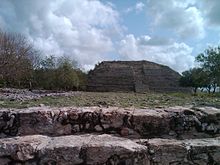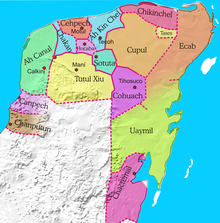Ah Kin Chel

Ah Kin Chel ( Mayathan : Ah Kin ch'el ) was a principality (Mayathan: kuchkabal ) of Maya on the Yucatan during the Postclassic that until the time of the Conquest had inventory.
description
The province of Ah Kin Chel borrowed its name from a military leader of the same name who established territorial rule there after the fall of Mayapán around the middle of the 15th century. Here Ah Kin is to be equated with priest and Ch'el , the actual proper name, stands for jay , possibly a blue raven .
Ah Kin Chel was surrounded by the jurisdictions of Chepech , Hocabá , Sotuta , Cupul and Chikinchel. The main town and the largest settlement at the same time was Tecoh. Other significant places were Sinanche, Yobain, Dzidzantun, Dzilam (Gonzales), Cansahcab, Temax, Dzoncauich, Buctzotz, Teya, Tepalam, Tekal, Tixkochoh, Tekanto, Citilcum, Kimbila, Sitilpech, Dzudzal, Chalmate, X. Izamal , where imposing stone buildings have been preserved as ruins, had lost its importance as a religious center before the fall of Mayan and was only a small village around 1500.
Ah Kin Chel extended territorially over a coastal strip in the central north of the Yucatan peninsula on the Gulf of Mexico of about 50 km in length and 30 km inland. The deepest extent inland was about 2/5 of the width of the coastal strip about 70 km.
At the time of the Conquista, the Halach Huinik Namux Chel († after 1523) ruled Tecoh, economically dominated by fishing, agriculture and salt extraction. Diplomatic relations with Hocaba were friendly, but Ah Kin Chel was enemies with Sotuta, and war raged with Chepech and Cupul. The ruling nobility was friendly towards the Spaniards and cooperated in the conquest of the Yucatan. In 1542 Francisco de Montejo (el sobrino) built a garrison in Tecoh to take action against the Cupul. In 1581 Tecoh was abandoned. Due to the effects of the conquest , only 37,755 residents were named in the Spanish tax list in 1549. Nevertheless, the ruling family and numerous nobles, as in most other Mayan cities on the Yucatan, were often able to continue to occupy leading positions even after the conquest and Christianization. Among the caciques and local governors from 1562 to 1581, numerous members of the old elite are named, including Francisco and Andrés Chel in Yobain, Juan Ek and Juan Chan in Temax, Diego Balam in Buctzotz, Juan Pot in Tekano.
literature
- Ralph L. Roys : The Political Geography of the Yucatan Maya. Washington 1957, pp. 78-91
